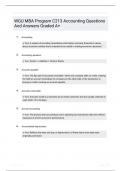Exam (elaborations)
WGU MBA Program C213 Accounting Questions And Answers Graded A+
- Course
- Institution
WGU MBA Program C213 Accounting Questions And Answers Graded A+ Accounting Accounting Equation Accounts Payable Accounts Receivable Accrual Accounting Accumulated Depreciation Accumulated Other Comprehensive Income Activity-based Costing (ABC) Additional Paid-in Capital American Institute...
[Show more]



